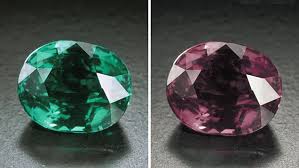
Alexandrite color change. Photo courtesy of GIA.
Have you ever seen a gemstone change from one color to another right before your eyes? If not, you’re in for a treat when you see your first fine alexandrite. Raspberry red in tungsten light or firelight, teal green in direct sunlight or fluorescent light – fine alexandrite is the color-change gemstone against which all other color-change gemstones are compared.
Discovered in 1830 in the Ural Mountains of Russia, alexandrite is named after Tsar Alexander II. Once it was noticed that the gemstone was green during the day and red during the fire-lit evenings (appropriately displaying the royal colors of Tsarist Russia), it was promptly adopted as Russia’s national gemstone. This turn of fate led to the belief that alexandrite endows with prosperity and good fortune.
The original Uralian mines are virtually tapped out now, but those first lodes of alexandrite are still considered the quality standard for all others. If you can find verifiable Russian alexandrite from the classic mines, expect to pay an extreme premium to obtain it, or be content to stare in wonder at some of the most breathtaking gems ever mined.
Top quality natural alexandrite can easily command upwards $25,000 per carat, being comparatively rarer than other gems like diamond, sapphire, and fine topaz. As such, most of the material you are likely to encounter will be less than top grade; many small-town jewelry stores even opt to keep a stock of synthetic alexandrite because high-grade natural material is just too expensive without the right clientele base, and the more affordable mid-grade natural material isn’t always as captivating as prices may seem to warrant. The rarity of alexandrite is legitimate, though, and if you like citrus colors, a mid-grade alex may be just right for you, as its color change is usually from a limey green to a honey brown.

Alexandrite showing inferior color change. Image courtesy of GIA.
Alexandrite is a bit of an odd duck in the world of colored gemstones. Where the vast majority of other colored gems are graded according to the quality of their color, the primary consideration in fine alexandrite is the degree of color change, which is a bit of a different spin on the traditional concept. A one carat, transparent, faceted, eye-clean alexandrite that changes incompletely from a limey-green to an orangey-brown will often cost less than a one carat, opaque cabochon alexandrite that shows a full color-change from bluish green to purplish pink. It is judged chiefly by the quality of each body color and the completeness of the chromatic shift from one to the other. Very rarely, alexandrite can occur with a cat’s eye or even, in astronomically rare circumstances, a four-rayed asterism (think only a handful ever found and verified). Alexandrite is also one of the three recognized birthstones for June.
Alexandrite is the color-change variety of the mineral chrysoberyl. It gets its colors and changeling abilities from trace impurities of the elements chromium and sometimes vanadium. Chromium is what makes the best red rubies and the best green emeralds, so premium alexandrite captures both. Chemically, it is composed of beryllium aluminum oxide. The growth of alexandrite holds a similar complication to that of emerald. Beryllium (a structural component) and chromium (the coloring agent) are almost mutually exclusive in natural rock formations. They don’t occur together as a rule, but tectonic activity is what usually brings them together.
Further complicating matters is the ubiquitous presence of silica (quartz) in the Earth. Silica is the most prevalent individual mineral in the Earth’s crust, and if it is present where beryllium and chromium meet, all you get is emeralds (only emeralds!?). Silica must be absent for alexandrite to grow. So the odds are seriously stacked against it, hence the justification of the price of alexandrite.
When you are out shopping for alexandrite, be prepared to either find very few natural stones or natural material more in the non-phenomenal chrysoberyl palates: brownish or orangey yellow that changes to various shades of green. The bulk of alexandrite is mined in Brazil and India nowadays, with some deposits also being worked in Sri Lanka and southeastern Africa. These gems are supplemented by vanadium impurities, whereas the Russian material is colored predominantly by chromium. That’s why many fine Brazilian stones have bluish tints to their greens (like Zambian emeralds), and why their reds rarely really get RED, but lean more towards a purplish hue.
As a chrysoberyl, alexandrite has outstanding physical properties. It is harder than most other gemstones typically found in jewelry (only sapphire/ruby and diamond are harder), it is not prone to cleavage, chipping, or fracturing (like diamond and emerald), and it is not heat or chemical sensitive (like all of the Beryl Family). Ultrasonic and steam cleaners are both safe, and you only have to keep your alexandrite jewelry compartmentalized from most other gems to keep it from damaging them.
Tags: alexandrite, chromium, colors, diamond, emeralds, gemstones, natural alexandrite, Russia, silica